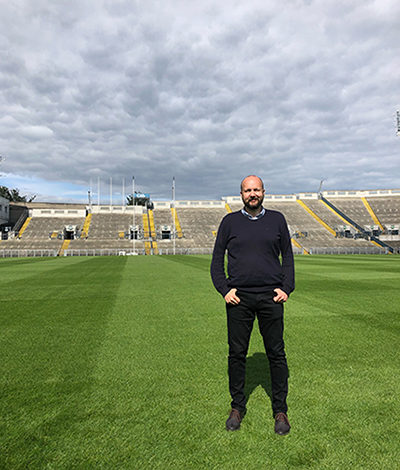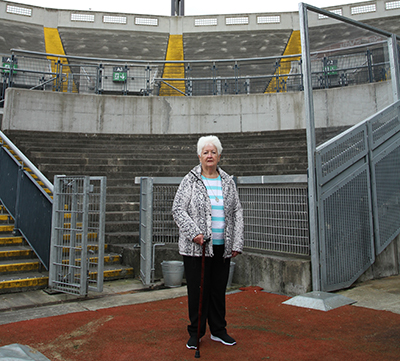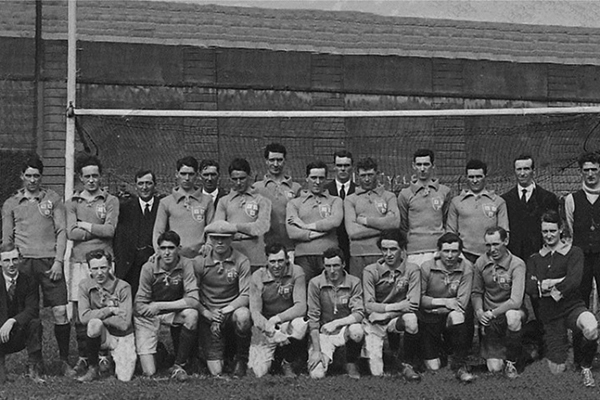Bloody Sunday 1920
Published in Issue 1 (January/February 2021), Reviews, Volume 29RTÉ1
15 November 2020
Produced by Colm O’Callaghan
By Donal Fallon

Above: Michael Foley—the documentary is adapted from his award-winning book The bloodied field. (RTÉ)
It is the familiar voice of Paul Rouse that opens Bloody Sunday 1920, RTÉ’s documentary exploring the events of perhaps the most dramatic day of the Irish revolution. Rouse, perhaps single-handedly, saved sports radio in Covid-19 times, his historical contributions to Newstalk’s ‘Off The Ball’ turning to the past at a time when very little was happening in the present. As he talks of a ‘quiet, sleepy city’ waking up a century ago, it is images of a contemporary quiet, sleepy city that we see on screen. It is a recurring feature of this documentary, the contemporary city and familiar streets in their present form utilised over talk of the past.
The feel of Bloody Sunday 1920 is that of a feature film. It is fast-paced, beautifully shot and tells us a tale in chronological order. Yet Bloody Sunday poses a serious challenge for any documentary-maker in that the day is one of such twists and turns, composed of three dramatic chapters. The morning assassinations, the massacre in Croke Park and the dramatic deaths of three prisoners in Dublin Castle are all complex tales in their own right, even before their intersections are taken into account.
Frustratingly, Bloody Sunday 1920, despite its title, which suggests an all-encompassing overview of the day, omits the later events of the evening entirely. The deaths of Peadar Clancy, Dick McKee and the unfortunate Conor Clune, a victim of circumstance and bad luck, do not feature here. Rather this tale centres on the morning of Bloody Sunday—or ‘Black Sunday’ to the British press—and the subsequent vicious reprisal in Croke Park.

Above: A descendant of one of the victims, Mary Flynn, at Croke Park. Those civilian lives take centre stage in Bloody Sunday 1920, as relatives give details of their lives, struggles and aspirations. (RTÉ)
The documentary is adapted from Michael Foley’s award-winning book The bloodied field. Foley’s ground-breaking work, which revealed much new detail on the civilian dead of the day and explained the massacre in minute-by-minute detail, is a strong bedrock. Those civilian lives take centre stage in Bloody Sunday 1920, as relatives give details of their lives, struggles and aspirations. Relations, who for almost a century were unique in knowing the names of the Croke Park dead (the point is well made that to nationalist Ireland they existed largely as a number), add colour to the stories of their ancestors. We learn of Jane Boyle, who was to be married days later, and Thomas Ryan, shot while whispering an Act of Contrition into the ear of a dying Michael Hogan.
The wry observation of an Irish Times reviewer of this documentary that ‘the documentary makers seem to have interviewed every historian in Dublin and beyond’ is hyperbole, but certainly there is an over-abundance of talking heads. When they provide unique insights from their research this is a tremendous benefit to the documentary, but when multiple voices provide the same narrative it is almost disorientating. Particularly strong contributions come from Anne Dolan, whose landmark 2006 article ‘Killing and Bloody Sunday, November 1920’ for The Historical Journal explored the deep psychological impact of participating in the events of that morning on the young men of ‘the Squad’. Some of those at the heart of events on a November morning in 1920 were, two years later, entangled in even murkier events of the Civil War. Similarly, there is much that is new in the contributions of David Leeson, a leading authority on the Auxiliaries and Black and Tans in the conflict. If Dolan gives us an insight into the mentality of young IRA Volunteers on the morning of Bloody Sunday, Leeson gives us an expert analysis of the breakdown of policing in Ireland and the psychology of reprisals.
In a bold aesthetic move, the documentary does not take sides on the question of historical re-enactment versus contemporary location shots: we are given both. Re-enactments are used sparingly, which increases their impact, showing nervous young men making their way through the Georgian doors of south inner-city Dublin. The contemporary shots have power, too—a reminder of the familiarity of the theatre of war that morning. There is real emotional weight in the footage of supporters, both Dublin and Tipperary, making their way to the contemporary Croke Park, a reminder that this is a ritual in which we ourselves still engage, never expecting it to be our last journey up Jones’s Road. We also see rich archival material, including interview footage of Vincent Byrne, the last survivor of ‘the Squad’, who had no regrets concerning the events of that morning. Byrne, who died in 1992, gave many interviews in the later years of his life, but a deep archival dive has also uncovered interviews with players like Tipperary’s Tommy Ryan, who recounted the terror of being on the field of play when the firing began.
Explaining a massacre in real time is difficult, but Bloody Sunday 1920 draws on brilliantly animated maps which show exactly how Crown forces entered the ground and explain just where the deaths occurred. Many viewers will be surprised to hear Michael Foley explain that not all who were killed in the stadium that day were shot. Panic at the presence of an armoured car firing into the air outside the stadium forced some fleeing spectators back into the chaos, leading to a crush on the field of play. That kind of detail is exactly what Foley has brought to our understanding of that day in his work. Few of us knew that the Dublin goalkeeper, Johnny McDonnell, had been ‘out’ that morning with an IRA assassination team. Fewer still, perhaps, knew that Tipperary’s goalkeeper, Frank Butler, had fought at the Somme.

Above: The Dublin team—goalkeeper Johnny McDonnell (‘the man with the cap’) had been ‘out’ that morning; Tipperary goalkeeper Frank Butler had fought at the Somme.
Bloody Sunday 1920 is the story of two-thirds of a day of death and destruction. Perhaps the title of Foley’s book, The bloodied field, would have better suited this documentary, which clearly demonstrates the intersections of the events of the morning and afternoon of 21 November 1920. To produce such a documentary in normal times would be a fine achievement, but in this most peculiar year of the Decade of Centenaries RTÉ have produced a rich work that sets a new standard for the future.
Donal Fallon is presenter of the Dublin social history podcast Three Castles Burning, and lectures in the Lifelong Learning Department of UCD.
















